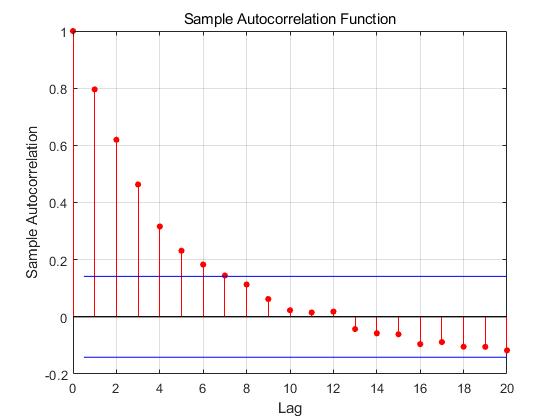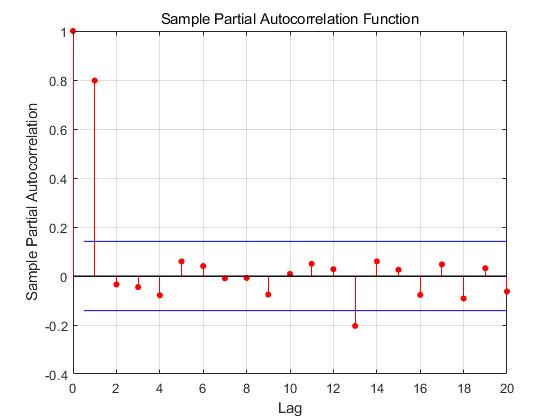matlab-AR模型的使用
Posted 朔漠君
tags:
篇首语:本文由小常识网(cha138.com)小编为大家整理,主要介绍了matlab-AR模型的使用相关的知识,希望对你有一定的参考价值。
AR模型概念
自回归模型,统计上处理时间序列的方法,使用同一变量的之前的数据,来预期本期的表现(前提存在线性关系)
公式定义
X
t
=
c
+
∑
i
=
1
p
φ
i
X
t
−
i
+
ε
t
X_t=c+\\sum_i=1^p\\varphi_iX_t-i+\\varepsilon_t
Xt=c+i=1∑pφiXt−i+εt
其中c是常数项;
ε
t
\\varepsilon_t
εt被假设为平均数等于0,标准差等于
σ
\\sigma
σ的随机误差值;
σ
\\sigma
σ被假设为对于任何的t都不变
matlab使用方法
clear
%生成模拟数据
x=2;
for k=1:199
x(k+1)=0.7*x(k)+3*randn(1,1);
end
clear k
%定阶,由于AR模型简单所以定阶容易
figure
autocorr(x)
figure
parcorr(x)
%ACF拖尾,PACF1阶截尾,应该用AR(1)模型
y=iddata([x,0,0]'); %转化为系统辨识工具箱能识别的数据类型
% 预测的关键是要在原有数据上加0。加k个,可以预测T+1—T+K以后的数据
% 在这里曾经讨论过,https://www.ilovematlab.cn/thread-23681-1-2.html
%不过当时好像没有说清楚
AR1=ar(x,1);%估计参数,AR1同y一样是一个结构数组
p1=predict(y(1:201),AR1,1);%1步预测
p2=predict(y(1:202),AR1,2);%2步预测
%提出预测数据,关于iddata类型的数据格式,可以看help
xp1=p1.OutputData;%预测
xp2=p2.OutputData;
%绘图
figure
plot(x,'g')
hold on
plot(xp1,'r')
hold on
plot(xp2,'black')
%绘制均方误差,可以看到2步预测>1步预测
figure
plot((xp1(1:200)-x').^2,'m')
hold on
plot((xp2(2:200)-x(2:200)').^2,'b')
参数讲解
- 拖尾 始终有非零取值,不会再K大于某个常数后就恒等于零(在0附近随机波动)
- 截尾 在大于某给常数k后快速趋于0为k阶截尾
看两个指标自相关(ACF)、偏相关(PACF)
- AR模型:自相关系数拖尾,偏相关系数截尾
- MA模型:自相关系数截尾,偏相关系数拖尾
- ARMA模型:两个都为拖尾


阶数确定
- AR模型观察PACF在多少阶后截断
- MA模型观察ACF在多少阶后截断
如上图就是AR(1)模型
参考
MJExtension使用
MJExtension使用
一、MJExtension第三方框架
提供了以下的一些方法实现:
- 简单的字典 --> 模型
- JSON字符串 --> 模型
- 复杂的字典 --> 模型 (模型里面包含了模型)
- 复杂的字典 --> 模型 (模型的数组属性里面又装着模型)
- 复杂的字典 --> 模型(模型属性名和字典的key不一样)
- 字典数组 --> 模型数组
- 模型 --> 字典
- 模型数组 --> 字典数组
- 字典 --> CoreData模型
- 归档与解档NSCoding
- 过滤字典的值
MJExtension框架是利用Obj-C的运行时机制编写的,现在iOS开发语言往Swift语言发展,我不太清楚Swift语言是否也有这种特性,该框架以后会不会在Swift语言上也发展下去不得而知,不过这个框架很轻量级,非常适合初级开发者去看它的源码,对理解Obj-C的运行时机制有非常大的帮助。
二、Runtime运行时机制简单了解
Runtime简称运行时,就是系统在运行的时候的一些机制,其中最主要的是消息机制。
OC的函数调用类似于消息发送,属于动态调用过程。在编译的时候并不能决定真正调用哪个函数。事实证明,在编译阶段,OC可以调用任何函数,即使这个函数并未实现,只要申明过就不会报错。而C语言在编译阶段就会报错。只有在真正运行的时候才会根据函数的名称找到对应的函数来调用。
例如,下面的这个代码在编译时会被转化:
/* OC方法调用 */
[obj makeTest];
/* 编译时Runtime会将上面的代码转为下面的消息发送 */
objc_msgSend(obj, @selector(makeText));iOS的顶层基类NSObject含有一个指向objc_class结构体的isa指针:
@interface NSObject{
Class isa;
};
typedef struct objc_class *Class;
struct objc_class {
Class isa; // 指向metaclass,也就是静态的Class
Class super_class ; // 指向其父类
const char *name ; // 类名
long version ; // 类的版本信息,初始化默认为0
/* 一些标识信息,如CLS_CLASS(0x1L)表示该类为普通class;
CLS_META(0x2L)表示该类为metaclass */
long info;
long instance_size ; // 该类的实例变量大小(包括从父类继承下来的实例变量);
struct objc_ivar_list *ivars; // 用于存储每个成员变量的地址
/* 与info的一些标志位有关,如是普通class则存储对象方法,如是metaclass则存储类方法; */
struct objc_method_list **methodLists ;
struct objc_cache *cache; // 指向最近使用的方法的指针,用于提升效率;
struct objc_protocol_list *protocols; // 存储该类遵守的协议
};
在objc_msgSend函数的调用过程:
- 首先通过obj的isa指针找到obj对应的Class。
- 在Class中先去
cache中通过SEL查找对应函数method- 若
cache中未找到,再去methodLists中查找- 若
methodLists中未找到,则进入superClass按前面的步骤进行递归查找- 若找到
method,则将method加入到cache中,以方便下次查找,并通过method中的函数指针跳转到对应的函数中去执行。- 如果一直查找到
NSObject还没查找到,则会进入消息动态处理流程。
消息动态处理流程:
/* 1. 时机处理之一,在这个方法中我们可以利用runtime的特性动态添加方法来处理 */
+ (BOOL)resolveInstanceMethod:(SEL)sel;
/* 2. 时机处理之二,在这个方法中看代理能不能处理,如果代理对象能处理,则转接给代理对象 */
- (id)forwardingTargetForSelector:(SEL)aSelector;
/* 3. 消息转发之一,该方法返回方法签名,如果返回nil,则转发流程终止,抛出异常 */
- (NSMethodSignature *)methodSignatureForSelector:(SEL)aSelector;
/* 4. 消息转发之二,在该方法中我们可以对调用方法进行重定向 */
- (void)forwardInvocation:(NSInvocation *)anInvocation;
所以使用Runtime机制我们就可以动态向类添加方法或属性:
/* 动态向一个类添加属性 */
class_addIvar(kclass, "expression", size, alignment, "*");
/* 动态向一个类添加方法 */
class_addMethod(kclass, @selector(setExpressionFormula:), (IMP)setExpressionFormula, "[email protected]:@");
class_addMethod(kclass, @selector(getExpressionFormula), (IMP)getExpressionFormula, "@@:");
static void setExpressionFormula(id self, SEL cmd, id value){
NSLog(@"call setExpressionFormula");
}
static id getExpressionFormula(id self, SEL cmd) {
NSLog(@"call getExpressionFormula");
return nil;
}
v表示void,@表示id类型,:表示SEL类型"[email protected]:@":表示返回值为void,接受一个id类型、一个SEL类型、一个id类型的方法"@@:":表示返回值为id类型,接受一个id类型和一个SEL类型参数的方法
具体Runtime运行时使用细节,这里就不细讲,只是简单了解下Runtime是可以做到动态向类添加属性和方法就行。
三、MJExtension使用
MJExtension的大部分方法实现都集成到了分类上,不需要使用新的类,只需要包含头文件MJExtension.h即可。MJExtension在github上的使用说明已经写得十分明白了。
1. 简单的字典 --> 模型
模型类User定义:
typedef enum {
SexMale,
SexFemale
} Sex;
@interface User : NSObject
@property (copy, nonatomic) NSString *name;/* 姓名 */
@property (copy, nonatomic) NSString *icon;/* 头像 */
@property (assign, nonatomic) unsigned int age;/* 年龄 */
@property (copy, nonatomic) NSString *height;/* 身高 */
@property (strong, nonatomic) NSNumber *money;/* 资产 */
@property (assign, nonatomic) Sex sex;/* 性别 */
@property (assign, nonatomic, getter=isGay) BOOL gay;/* 是否是同性恋 */
@end使用实例:
NSDictionary *dict = @{
@"name" : @"Jack",
@"icon" : @"lufy.png",
@"age" : @20,
@"height" : @"1.55",
@"money" : @100.9,
@"sex" : @(SexFemale),/* 枚举需要使用NSNumber包装 */
@"gay" : @"NO"
};
//字典转模型,使用的是mj_objectWithKeyValues:方法
User *user = [User mj_objectWithKeyValues:dict];2. JSON字符串 --> 模型
使用实例:
// 定义一个JSON字符串
NSString *jsonString = @"{\"name\":\"Jack\", \"icon\":\"lufy.png\", \"age\":20}";
// JSON字符串转模型
User *user = [User mj_objectWithKeyValues:jsonString];3. 复杂的字典 --> 模型 (模型里面包含了模型)
模型类Status定义:
@interface Status : NSObject
@property (copy, nonatomic) NSString *text;
@property (strong, nonatomic) User *user;/* 其他模型类型 */
@property (strong, nonatomic) Status *retweetedStatus;/* 自我模型类型 */
@end使用实例:
NSDictionary *dict = @{
@"text" : @"Agree!Nice weather!",
@"user" : @{
@"name" : @"Jack",
@"icon" : @"lufy.png"
},
@"retweetedStatus" : @{
@"text" : @"Nice weather!",
@"user" : @{
@"name" : @"Rose",
@"icon" : @"nami.png"
}
}
};
//字典转模型,模型里面含有模型
Status *status = [Status mj_objectWithKeyValues:dict];
NSString *text = status.text;
NSString *name = status.user.name;
NSString *icon = status.user.icon;
NSLog(@"text=%@, name=%@, icon=%@", text, name, icon);
// text=Agree!Nice weather!, name=Jack, icon=lufy.png
NSString *text2 = status.retweetedStatus.text;
NSString *name2 = status.retweetedStatus.user.name;
NSString *icon2 = status.retweetedStatus.user.icon;
NSLog(@"text2=%@, name2=%@, icon2=%@", text2, name2, icon2);
// text2=Nice weather!, name2=Rose, icon2=nami.png4. 复杂的字典 --> 模型 (模型的数组属性里面又装着模型)
模型类Ad和StatusResult定义:
@interface Ad : NSObject
@property (copy, nonatomic) NSString *image;
@property (copy, nonatomic) NSString *url;
@end
@interface StatusResult : NSObject
/** 数组中存储模型Status类型数据 */
@property (strong, nonatomic) NSMutableArray *statuses;
/** 数组中存储模型Ad类型数据 */
@property (strong, nonatomic) NSArray *ads;
@property (strong, nonatomic) NSNumber *totalNumber;
@end
#import "MJExtension.h"
/* 数组中存储模型数据,需要说明数组中存储的模型数据类型 */
@implementation StatusResult
/* 实现该方法,说明数组中存储的模型数据类型 */
+ (NSDictionary *)mj_ objectClassInArray{
return @{ @"statuses" : @"Status",
@"ads" : @"Ad"
};
}
@end使用实例:
NSDictionary *dict = @{
@"statuses" : @[
@{
@"text" : @"Nice weather!",
@"user" : @{
@"name" : @"Rose",
@"icon" : @"nami.png"
}
},
@{
@"text" : @"Go camping tomorrow!",
@"user" : @{
@"name" : @"Jack",
@"icon" : @"lufy.png"
}
}
],
@"ads" : @[
@{
@"image" : @"ad01.png",
@"url" : @"http://www.ad01.com"
},
@{
@"image" : @"ad02.png",
@"url" : @"http://www.ad02.com"
}
],
@"totalNumber" : @"2014"
};
//字典转模型,支持模型的数组属性里面又装着模型
StatusResult *result = [StatusResult mj_objectWithKeyValues:dict];
//打印博主信息
for (Status *status in result.statuses) {
NSString *text = status.text;
NSString *name = status.user.name;
NSString *icon = status.user.icon;
NSLog(@"text=%@, name=%@, icon=%@", text, name, icon);
}
// text=Nice weather!, name=Rose, icon=nami.png
// text=Go camping tomorrow!, name=Jack, icon=lufy.png
//打印广告
for (Ad *ad in result.ads) {
NSLog(@"image=%@, url=%@", ad.image, ad.url);
}
// image=ad01.png, url=http://www.ad01.com
// image=ad02.png, url=http://www.ad02.com5. 复杂的字典 --> 模型(模型属性名和字典的key不一样)
模型类Bag和Student定义:
@interface Bag : NSObject
@property (copy, nonatomic) NSString *name;
@property (assign, nonatomic) double price;
@end
@interface Student : NSObject
@property (copy, nonatomic) NSString *ID;
@property (copy, nonatomic) NSString *desc;
@property (copy, nonatomic) NSString *nowName;
@property (copy, nonatomic) NSString *oldName;
@property (copy, nonatomic) NSString *nameChangedTime;
@property (strong, nonatomic) Bag *bag;
@end
#import "MJExtension.h"
@implementation
/* 设置模型属性名和字典key之间的映射关系 */
+ (NSDictionary *)mj_replacedKeyFromPropertyName{
/* 返回的字典,key为模型属性名,value为转化的字典的多级key */
return @{
@"ID" : @"id",
@"desc" : @"desciption",
@"oldName" : @"name.oldName",
@"nowName" : @"name.newName",
@"nameChangedTime" : @"name.info[1].nameChangedTime",
@"bag" : @"other.bag"
};
}
@end使用实例:
NSDictionary *dict = @{
@"id" : @"20",
@"desciption" : @"kids",
@"name" : @{
@"newName" : @"lufy",
@"oldName" : @"kitty",
@"info" : @[
@"test-data",
@{
@"nameChangedTime" : @"2013-08"
}
]
},
@"other" : @{
@"bag" : @{
@"name" : @"a red bag",
@"price" : @100.7
}
}
};
//字典转模型,支持多级映射
Student *stu = [Student mj_objectWithKeyValues:dict];
//打印
NSLog(@"ID=%@, desc=%@, oldName=%@, nowName=%@, nameChangedTime=%@",
stu.ID, stu.desc, stu.oldName, stu.nowName, stu.nameChangedTime);
// ID=20, desc=kids, oldName=kitty, nowName=lufy, nameChangedTime=2013-08
NSLog(@"bagName=%@, bagPrice=%f", stu.bag.name, stu.bag.price);
// bagName=a red bag, bagPrice=100.7000006. 字典数组 --> 模型数组
使用实例:
NSArray *dictArray = @[
@{
@"name" : @"Jack",
@"icon" : @"lufy.png"
},
@{
@"name" : @"Rose",
@"icon" : @"nami.png"
}
];
//字典数组转模型数组,使用的是mj_objectArrayWithKeyValuesArray:方法
NSArray *userArray = [User mj_objectArrayWithKeyValuesArray:dictArray];
//打印
for (User *user in userArray) {
NSLog(@"name=%@, icon=%@", user.name, user.icon);
}
// name=Jack, icon=lufy.png
// name=Rose, icon=nami.png7. 模型 --> 字典
使用实例:
//创建一个模型对象
User *user = [[User alloc] init];
user.name = @"Jack";
user.icon = @"lufy.png";
Status *status = [[Status alloc] init];
status.user = user;
status.text = @"Nice mood!";
//模型转字典,使用的是mj_keyValues属性
NSDictionary *statusDict = status.mj_keyValues;
NSLog(@"%@", statusDict);
/*
{
text = "Nice mood!";
user = {
icon = "lufy.png";
name = Jack;
};
}
*/8. 模型数组 --> 字典数组
使用实例:
//创建模型数组
User *user1 = [[User alloc] init];
user1.name = @"Jack";
user1.icon = @"lufy.png";
User *user2 = [[User alloc] init];
user2.name = @"Rose";
user2.icon = @"nami.png";
NSArray *userArray = @[user1, user2];
//模型数组转字典数组,使用的是mj_keyValuesArrayWithObjectArray:方法
NSArray *dictArray = [User mj_keyValuesArrayWithObjectArray:userArray];
NSLog(@"%@", dictArray);
/*
(
{
icon = "lufy.png";
name = Jack;
},
{
icon = "nami.png";
name = Rose;
}
)
*/9. 字典 --> CoreData模型
使用实例:
NSDictionary *dict = @{
@"name" : @"Jack",
@"icon" : @"lufy.png",
@"age" : @20,
@"height" : @1.55,
@"money" : @"100.9",
@"sex" : @(SexFemale),
@"gay" : @"true"
};
//字典转为CoreData模型
NSManagedObjectContext *context = nil;
User *user = [User mj_objectWithKeyValues:dict
context:context];
[context save:nil];10. 归档与解档NSCoding
模型类Bag添加实现:
@interface Bag : NSObject <NSCoding>
@property (copy, nonatomic) NSString *name;
@property (assign, nonatomic) double price;
@end
#import "MJExtension.h"
@implementation Bag
//添加了下面的宏定义
MJExtensionCodingImplementation
/* 实现下面的方法,说明哪些属性不需要归档和解档 */
+ (NSArray *)mj_ignoredCodingPropertyNames{
return @[@"name"];
}
@end使用实例:
//创建模型
Bag *bag = [[Bag alloc] init];
bag.name = @"Red bag";
bag.price = 200.8;
//获取归档路径
NSString *file = [NSHomeDirectory() stringByAppendingPathComponent:@"Desktop/bag.data"];
//归档
[NSKeyedArchiver archiveRootObject:bag toFile:file];
//解档
Bag *decodedBag = [NSKeyedUnarchiver unarchiveObjectWithFile:file];
NSLog(@"name=%@, price=%f", decodedBag.name, decodedBag.price);
// name=(null), price=200.80000011. 过滤字典的值
模型类Book实现:
@interface Book: NSObject
@property (copy, nonatomic) NSString *name;
@property (strong, nonatomic) NSDate *publishedTime;
@end
#import "MJExtension.h"
@implementation Book
/* 转化过程中对字典的值进行过滤和进一步转化 */
- (id)mj_newValueFromOldValue:(id)oldValue property:(MJProperty *)property
{
if ([property.name isEqualToString:@"publisher"]) {
if (oldValue == nil) {
return @"";
}
} else if (property.type.typeClass == [NSDate class]) {
NSDateFormatter *fmt = [[NSDateFormatter alloc] init];
fmt.dateFormat = @"yyyy-MM-dd";
return [fmt dateFromString:oldValue];
}
return oldValue;
}
@end使用实例:
NSDictionary *dict = @{
@"name" : @"5分钟突破iOS开发",
@"publishedTime" : @"2011-09-10"
};
//字典转模型,过滤name为nil的情况,把NSString转为NSDate
Book *book = [Book mj_objectWithKeyValues:dict];
//打印
NSLog(@"name=%@, publishedTime=%@", book.name, book.publishedTime);以上是关于matlab-AR模型的使用的主要内容,如果未能解决你的问题,请参考以下文章